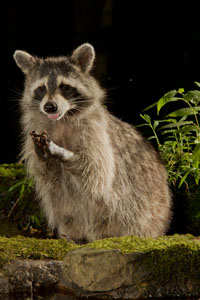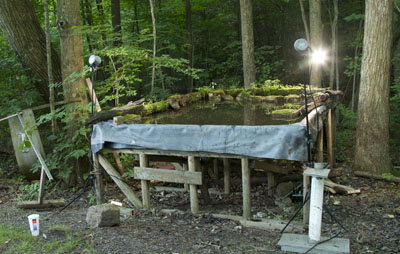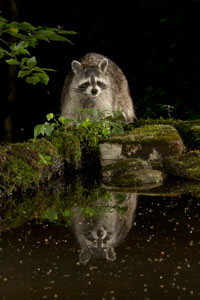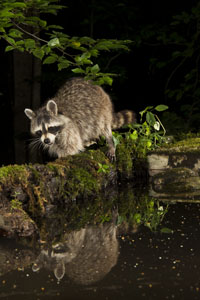The Story Behind the Photograph
July 2011
How I photographed this Raccoon

Every summer, every night, I crack 30 to 40 pecan nuts and place the pieces on a couple of bait sets where, I hope, Southern Flying Squirrels will glide in to feed. During our Digital Complete Nature Photo Courses we usually take an evening or two, after class time, for our participants to test their flash skills and knowledge photographing the squirrels. This year, squirrels have been few and very wary and those that have come in to the bait were doing so late, making the shooting not worth our time (at least for our first course, just held in June).
However, the pecans attracted other scroungers, including opossums and raccoons. Over the last several days at least one of these raccoons has been fairly tame, and whenever I walked by I'd move slowly and reasonably quietly, all the while talking to the raccoon to acquaint it with my voice and movement. After a few nights the raccoon was fairly oblivious to me.
Near our squirrel station, and almost directly in front of our teaching studio located in our woods, I've erected an 8 foot by 12 foot water set that is 4 to 6 inches deep. We usually use this water set for photographing crocodilians or large pythons or constrictors during our Reptiles of the World Photo Shoot, but that's just once a year.

Here's the water set which is mounted above ground level at around a three foot height. Mounted this way, it is easy to shoot an eye- or water-level perspective of a raccoon, squirrel, or bird that comes to the set. Three flashes are mounted, and the backlight is visible in the upper right corner. The other two flashes are visible as gray, round units mounted on the light stands..
It didn't take much coaxing to have the raccoons switch from the flying squirrel bait station to another one located at the water set. Since the raccoons came in after dark flash was needed, and the easiest setup this time was simply mounting my Dynalight studio flashes on three Manfrotto light stands mounted on each of three corners. These flashes operate only on a Manual mode, so I set my camera for the fastest flash synch speed and the aperture based upon the flashes. That lighting varied as a raccoon moved around the edge of the set, but it soon became fairly easy to adjust -- sometimes by resorting to the camera's LCD monitor to check an exposure.
One of our Lightroom Participants was staying over for our reptile shoot, so I had him shoot the raccoon one night. Although he managed to get some shots, his cameras continually malfunctioned. First, his Canon 7D would not fire his flash, which triggered my studio flashes. We switched cameras, and everything worked with his Canon 5D. Later, he discovered that his 7D camera settings were set for 'disable flash', a feature I'd never even noticed! The next day, his flash indeed did work. His second problem involved his flashes, which he needed to turn off and on and, in doing so, apparently had the flash default to TTL. This doesn't work, since the preflash of the TTL triggers the studio flash BEFORE the shutter opens. This happens in milliseconds, and to the photographer everything seems fine, as the camera flash fires and the studio flashes fire, like they should, but the results are a black image. With a Manual setting, there is only one flash pop, and that triggers the studio flashes.
The lighting was very straightforward. The two corner flashes functioned as Key lights, and the back flash created a nice 3-d effect or a strong hair light effect. My Canon flash, set on manual mode at 1/16th power, triggered the built-in slave of the Dynalights.


These raccoons were baited to the water set, which is a touchy, debatable issue when dealing with mammals. I wasn't too bothered by this for two reasons. One, and the primary one, is that a raccoon or several raccoons visit our property every night, taking the flying squirrels' pecans and raiding all of our sunflower feeders for our diurnal birds. Whether I'm placing bait at a specific spot or not, the raccoons would be commuting back and forth by the water set. Two, I'm doing my photography on my land, and I'm not, nor would I, baiting in a public area -- park or refuge.
While we often see Opossums, and two weeks ago had a family of Mink run across our road, and last year had a family of Weasels pass through, so far my shooting and my camera-traps have only involved raccoons. Hopefully, as the summer zips by for us (we'll be leaving for Jaguars by late August!), I'll have some chances for other species as well.
Past Stories Behind the Photograph
The Pileated Woodpecker
The Story Behind the Photograph
July 2011
How I photographed this Raccoon

Every summer, every night, I crack 30 to 40 pecan nuts and place the pieces on a couple of bait sets where, I hope, Southern Flying Squirrels will glide in to feed. During our Digital Complete Nature Photo Courses we usually take an evening or two, after class time, for our participants to test their flash skills and knowledge photographing the squirrels. This year, squirrels have been few and very wary and those that have come in to the bait were doing so late, making the shooting not worth our time (at least for our first course, just held in June).
However, the pecans attracted other scroungers, including opossums and raccoons. Over the last several days at least one of these raccoons has been fairly tame, and whenever I walked by I'd move slowly and reasonably quietly, all the while talking to the raccoon to acquaint it with my voice and movement. After a few nights the raccoon was fairly oblivious to me.
Near our squirrel station, and almost directly in front of our teaching studio located in our woods, I've erected an 8 foot by 12 foot water set that is 4 to 6 inches deep. We usually use this water set for photographing crocodilians or large pythons or constrictors during our Reptiles of the World Photo Shoot, but that's just once a year.

Here's the water set which is mounted above ground level at around a three foot height. Mounted this way, it is easy to shoot an eye- or water-level perspective of a raccoon, squirrel, or bird that comes to the set. Three flashes are mounted, and the backlight is visible in the upper right corner. The other two flashes are visible as gray, round units mounted on the light stands..
It didn't take much coaxing to have the raccoons switch from the flying squirrel bait station to another one located at the water set. Since the raccoons came in after dark flash was needed, and the easiest setup this time was simply mounting my Dynalight studio flashes on three Manfrotto light stands mounted on each of three corners. These flashes operate only on a Manual mode, so I set my camera for the fastest flash synch speed and the aperture based upon the flashes. That lighting varied as a raccoon moved around the edge of the set, but it soon became fairly easy to adjust -- sometimes by resorting to the camera's LCD monitor to check an exposure.
One of our Lightroom Participants was staying over for our reptile shoot, so I had him shoot the raccoon one night. Although he managed to get some shots, his cameras continually malfunctioned. First, his Canon 7D would not fire his flash, which triggered my studio flashes. We switched cameras, and everything worked with his Canon 5D. Later, he discovered that his 7D camera settings were set for 'disable flash', a feature I'd never even noticed! The next day, his flash indeed did work. His second problem involved his flashes, which he needed to turn off and on and, in doing so, apparently had the flash default to TTL. This doesn't work, since the preflash of the TTL triggers the studio flash BEFORE the shutter opens. This happens in milliseconds, and to the photographer everything seems fine, as the camera flash fires and the studio flashes fire, like they should, but the results are a black image. With a Manual setting, there is only one flash pop, and that triggers the studio flashes.
The lighting was very straightforward. The two corner flashes functioned as Key lights, and the back flash created a nice 3-d effect or a strong hair light effect. My Canon flash, set on manual mode at 1/16th power, triggered the built-in slave of the Dynalights.


These raccoons were baited to the water set, which is a touchy, debatable issue when dealing with mammals. I wasn't too bothered by this for two reasons. One, and the primary one, is that a raccoon or several raccoons visit our property every night, taking the flying squirrels' pecans and raiding all of our sunflower feeders for our diurnal birds. Whether I'm placing bait at a specific spot or not, the raccoons would be commuting back and forth by the water set. Two, I'm doing my photography on my land, and I'm not, nor would I, baiting in a public area -- park or refuge.
While we often see Opossums, and two weeks ago had a family of Mink run across our road, and last year had a family of Weasels pass through, so far my shooting and my camera-traps have only involved raccoons. Hopefully, as the summer zips by for us (we'll be leaving for Jaguars by late August!), I'll have some chances for other species as well.
Past Stories Behind the Photograph
The Pileated Woodpecker
The Story Behind the Photograph
July 2011
How I photographed this Raccoon

Every summer, every night, I crack 30 to 40 pecan nuts and place the pieces on a couple of bait sets where, I hope, Southern Flying Squirrels will glide in to feed. During our Digital Complete Nature Photo Courses we usually take an evening or two, after class time, for our participants to test their flash skills and knowledge photographing the squirrels. This year, squirrels have been few and very wary and those that have come in to the bait were doing so late, making the shooting not worth our time (at least for our first course, just held in June).
However, the pecans attracted other scroungers, including opossums and raccoons. Over the last several days at least one of these raccoons has been fairly tame, and whenever I walked by I'd move slowly and reasonably quietly, all the while talking to the raccoon to acquaint it with my voice and movement. After a few nights the raccoon was fairly oblivious to me.
Near our squirrel station, and almost directly in front of our teaching studio located in our woods, I've erected an 8 foot by 12 foot water set that is 4 to 6 inches deep. We usually use this water set for photographing crocodilians or large pythons or constrictors during our Reptiles of the World Photo Shoot, but that's just once a year.

Here's the water set which is mounted above ground level at around a three foot height. Mounted this way, it is easy to shoot an eye- or water-level perspective of a raccoon, squirrel, or bird that comes to the set. Three flashes are mounted, and the backlight is visible in the upper right corner. The other two flashes are visible as gray, round units mounted on the light stands..
It didn't take much coaxing to have the raccoons switch from the flying squirrel bait station to another one located at the water set. Since the raccoons came in after dark flash was needed, and the easiest setup this time was simply mounting my Dynalight studio flashes on three Manfrotto light stands mounted on each of three corners. These flashes operate only on a Manual mode, so I set my camera for the fastest flash synch speed and the aperture based upon the flashes. That lighting varied as a raccoon moved around the edge of the set, but it soon became fairly easy to adjust -- sometimes by resorting to the camera's LCD monitor to check an exposure.
One of our Lightroom Participants was staying over for our reptile shoot, so I had him shoot the raccoon one night. Although he managed to get some shots, his cameras continually malfunctioned. First, his Canon 7D would not fire his flash, which triggered my studio flashes. We switched cameras, and everything worked with his Canon 5D. Later, he discovered that his 7D camera settings were set for 'disable flash', a feature I'd never even noticed! The next day, his flash indeed did work. His second problem involved his flashes, which he needed to turn off and on and, in doing so, apparently had the flash default to TTL. This doesn't work, since the preflash of the TTL triggers the studio flash BEFORE the shutter opens. This happens in milliseconds, and to the photographer everything seems fine, as the camera flash fires and the studio flashes fire, like they should, but the results are a black image. With a Manual setting, there is only one flash pop, and that triggers the studio flashes.
The lighting was very straightforward. The two corner flashes functioned as Key lights, and the back flash created a nice 3-d effect or a strong hair light effect. My Canon flash, set on manual mode at 1/16th power, triggered the built-in slave of the Dynalights.


These raccoons were baited to the water set, which is a touchy, debatable issue when dealing with mammals. I wasn't too bothered by this for two reasons. One, and the primary one, is that a raccoon or several raccoons visit our property every night, taking the flying squirrels' pecans and raiding all of our sunflower feeders for our diurnal birds. Whether I'm placing bait at a specific spot or not, the raccoons would be commuting back and forth by the water set. Two, I'm doing my photography on my land, and I'm not, nor would I, baiting in a public area -- park or refuge.
While we often see Opossums, and two weeks ago had a family of Mink run across our road, and last year had a family of Weasels pass through, so far my shooting and my camera-traps have only involved raccoons. Hopefully, as the summer zips by for us (we'll be leaving for Jaguars by late August!), I'll have some chances for other species as well.
Past Stories Behind the Photograph
The Pileated Woodpecker
The Story Behind the Photograph
July 2011
How I photographed this Raccoon

Every summer, every night, I crack 30 to 40 pecan nuts and place the pieces on a couple of bait sets where, I hope, Southern Flying Squirrels will glide in to feed. During our Digital Complete Nature Photo Courses we usually take an evening or two, after class time, for our participants to test their flash skills and knowledge photographing the squirrels. This year, squirrels have been few and very wary and those that have come in to the bait were doing so late, making the shooting not worth our time (at least for our first course, just held in June).
However, the pecans attracted other scroungers, including opossums and raccoons. Over the last several days at least one of these raccoons has been fairly tame, and whenever I walked by I'd move slowly and reasonably quietly, all the while talking to the raccoon to acquaint it with my voice and movement. After a few nights the raccoon was fairly oblivious to me.
Near our squirrel station, and almost directly in front of our teaching studio located in our woods, I've erected an 8 foot by 12 foot water set that is 4 to 6 inches deep. We usually use this water set for photographing crocodilians or large pythons or constrictors during our Reptiles of the World Photo Shoot, but that's just once a year.

Here's the water set which is mounted above ground level at around a three foot height. Mounted this way, it is easy to shoot an eye- or water-level perspective of a raccoon, squirrel, or bird that comes to the set. Three flashes are mounted, and the backlight is visible in the upper right corner. The other two flashes are visible as gray, round units mounted on the light stands..
It didn't take much coaxing to have the raccoons switch from the flying squirrel bait station to another one located at the water set. Since the raccoons came in after dark flash was needed, and the easiest setup this time was simply mounting my Dynalight studio flashes on three Manfrotto light stands mounted on each of three corners. These flashes operate only on a Manual mode, so I set my camera for the fastest flash synch speed and the aperture based upon the flashes. That lighting varied as a raccoon moved around the edge of the set, but it soon became fairly easy to adjust -- sometimes by resorting to the camera's LCD monitor to check an exposure.
One of our Lightroom Participants was staying over for our reptile shoot, so I had him shoot the raccoon one night. Although he managed to get some shots, his cameras continually malfunctioned. First, his Canon 7D would not fire his flash, which triggered my studio flashes. We switched cameras, and everything worked with his Canon 5D. Later, he discovered that his 7D camera settings were set for 'disable flash', a feature I'd never even noticed! The next day, his flash indeed did work. His second problem involved his flashes, which he needed to turn off and on and, in doing so, apparently had the flash default to TTL. This doesn't work, since the preflash of the TTL triggers the studio flash BEFORE the shutter opens. This happens in milliseconds, and to the photographer everything seems fine, as the camera flash fires and the studio flashes fire, like they should, but the results are a black image. With a Manual setting, there is only one flash pop, and that triggers the studio flashes.
The lighting was very straightforward. The two corner flashes functioned as Key lights, and the back flash created a nice 3-d effect or a strong hair light effect. My Canon flash, set on manual mode at 1/16th power, triggered the built-in slave of the Dynalights.


These raccoons were baited to the water set, which is a touchy, debatable issue when dealing with mammals. I wasn't too bothered by this for two reasons. One, and the primary one, is that a raccoon or several raccoons visit our property every night, taking the flying squirrels' pecans and raiding all of our sunflower feeders for our diurnal birds. Whether I'm placing bait at a specific spot or not, the raccoons would be commuting back and forth by the water set. Two, I'm doing my photography on my land, and I'm not, nor would I, baiting in a public area -- park or refuge.
While we often see Opossums, and two weeks ago had a family of Mink run across our road, and last year had a family of Weasels pass through, so far my shooting and my camera-traps have only involved raccoons. Hopefully, as the summer zips by for us (we'll be leaving for Jaguars by late August!), I'll have some chances for other species as well.
Past Stories Behind the Photograph
The Pileated Woodpecker


